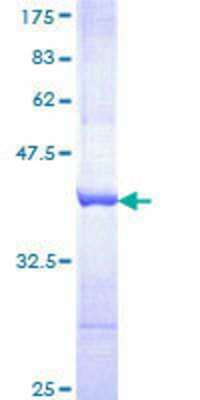PSD-95 Products
PSD-95 (postsynaptic density-95 kDa; also SAP90) is a 95 kDa member of the MAGUK (membrane-associated guanylate kinase) family of molecules. It is a multidomain protein that serves as a scaffold, or anchor, for the organization of structural and signal transduction pathways in neurons. PSD-95 is capable of forming multimers, generating large com...
65 results for "PSD-95" in Products
65 results for "PSD-95" in Products
PSD-95 Products
PSD-95 (postsynaptic density-95 kDa; also SAP90) is a 95 kDa member of the MAGUK (membrane-associated guanylate kinase) family of molecules. It is a multidomain protein that serves as a scaffold, or anchor, for the organization of structural and signal transduction pathways in neurons. PSD-95 is capable of forming multimers, generating large com...
| Reactivity: | Human, Mouse, Rat, Primate, Invertebrate, +1 More |
| Details: | Mouse IgG2A Monoclonal Clone #6G6-1C9 |
| Applications: | IHC, WB, ICC/IF, Flow, IP, +2 More |
| Reactivity: | Human, Mouse, Rat, Bovine |
| Details: | Mouse IgG1 Monoclonal Clone #7E3 |
| Applications: | IHC, WB, ICC/IF, MA |
| Reactivity: | Mouse, Rat |
| Details: | Rabbit IgG Polyclonal |
| Applications: | WB |
| Reactivity: | Human, Mouse, Rat |
| Details: | Rabbit IgG Polyclonal |
| Applications: | WB |
| Reactivity: | Human |
| Details: | Rabbit IgG Polyclonal |
| Applications: | IHC, WB, ICC/IF |
| Applications: | WB, ELISA, Func, MA, AP |
| Reactivity: | Mouse, Rat, Bovine |
| Details: | Mouse IgG2A Monoclonal Clone #7E3-1B8 |
| Applications: | WB |
| Reactivity: | Rat |
| Details: | Goat IgG Polyclonal |
| Applications: | WB, ELISA |
| Reactivity: | Human |
| Details: | Rabbit IgG Polyclonal |
| Applications: | IHC, WB |
Recombinant monoclonal antibody expressed in HEK293F cells
| Reactivity: | Human, Mouse, Rat |
| Details: | Rabbit IgG Monoclonal Clone #1H4 |
| Applications: | WB, ELISA |
Recombinant Monoclonal Antibody
| Reactivity: | Mouse, Rat |
| Details: | Rabbit IgG Monoclonal Clone #0M7N4 |
| Applications: | WB |
| Applications: | WB, ELISA, MA, AP |
| Reactivity: | Human, Mouse, Rat |
| Details: | Mouse IgG1 Monoclonal Clone #OTI12A5 |
| Applications: | WB |
| Reactivity: | Human, Mouse, Rat |
| Details: | Mouse IgG1 Monoclonal Clone #OTI12A5 |
| Applications: | WB |
| Reactivity: | Human, Mouse, Rat, Primate, Invertebrate |
| Details: | Mouse IgG2A Monoclonal Clone #6G6-1C9 |
| Applications: | IHC, WB, ICC/IF, Flow, IP, +2 More |
| Reactivity: | Human, Mouse, Rat, Primate, Invertebrate |
| Details: | Mouse IgG2A Monoclonal Clone #6G6-1C9 |
| Applications: | IHC, WB, ICC/IF, Flow, IP, +2 More |
| Reactivity: | Human, Mouse, Rat |
| Details: | Mouse IgG1 Monoclonal Clone #OTI12A5 |
| Applications: | WB |
| Reactivity: | Human, Mouse, Rat, Primate, Invertebrate |
| Details: | Mouse IgG2A Monoclonal Clone #6G6-1C9 |
| Applications: | IHC, WB, ICC/IF, Flow, IP, +2 More |
| Reactivity: | Human, Mouse, Rat |
| Details: | Mouse IgG1 Monoclonal Clone #OTI12A5 |
| Applications: | WB |
| Reactivity: | Human, Mouse, Rat |
| Details: | Mouse IgG1 Monoclonal Clone #OTI12A5 |
| Applications: | WB |
| Reactivity: | Human, Mouse, Rat, Primate, Invertebrate |
| Details: | Mouse IgG2A Monoclonal Clone #6G6-1C9 |
| Applications: | IHC, WB, ICC/IF, Flow, IP, +2 More |
| Reactivity: | Human, Mouse, Rat, Primate, Invertebrate |
| Details: | Mouse IgG2A Monoclonal Clone #6G6-1C9 |
| Applications: | IHC, WB, ICC/IF, Flow, IP, +2 More |
| Reactivity: | Human, Mouse, Rat |
| Details: | Mouse IgG1 Monoclonal Clone #OTI12A5 |
| Applications: | WB |
| Reactivity: | Human, Mouse, Rat |
| Details: | Mouse IgG1 Monoclonal Clone #OTI12A5 |
| Applications: | WB |
| Reactivity: | Human, Mouse, Rat |
| Details: | Mouse IgG1 Monoclonal Clone #OTI12A5 |
| Applications: | WB |

![Western Blot: PSD-95 Antibody (6G6-1C9)BSA Free [NB300-556] Western Blot: PSD-95 Antibody (6G6-1C9)BSA Free [NB300-556]](https://resources.bio-techne.com/images/products/PSD-95-Antibody-6G6-1C9-Western-Blot-NB300-556-img0020.jpg)
![Western Blot: PSD-95 Antibody (7E3) [NBP2-12872] Western Blot: PSD-95 Antibody (7E3) [NBP2-12872]](https://resources.bio-techne.com/images/products/PSD-95-Antibody-7E3-Western-Blot-NBP2-12872-img0013.jpg)
![Western Blot: PSD-95 Antibody [NB300-294] Western Blot: PSD-95 Antibody [NB300-294]](https://resources.bio-techne.com/images/products/PSD-95-Antibody-Western-Blot-NB300-294-img0001.jpg)


![Immunohistochemistry-Paraffin: PSD-95 Antibody [NBP1-80875] Immunohistochemistry-Paraffin: PSD-95 Antibody [NBP1-80875]](https://resources.bio-techne.com/images/products/PSD-95-Antibody-Immunohistochemistry-Paraffin-NBP1-80875-img0005.jpg)
![SDS-PAGE: Recombinant Human PSD-95 GST (N-Term) Protein [H00001742-P01] SDS-PAGE: Recombinant Human PSD-95 GST (N-Term) Protein [H00001742-P01]](https://resources.bio-techne.com/images/products/Recombinant-Human-PSD-95-Protein-SDS-Page-H00001742-P01-img0002.jpg)
![Western Blot: PSD-95 Antibody (7E3-1B8) [NBP1-97531] Western Blot: PSD-95 Antibody (7E3-1B8) [NBP1-97531]](https://resources.bio-techne.com/images/products/PSD95-Antibody-7E3-1B8-Western-Blot-NBP1-97531-img0001.jpg)
![Western Blot: PSD-95 Antibody [NBP1-68836] Western Blot: PSD-95 Antibody [NBP1-68836]](https://resources.bio-techne.com/images/products/pan-MAGUK-Antibody-Western-Blot-NBP1-68836-img0001.jpg)
![Immunohistochemistry-Paraffin: PSD-95 Antibody [NBP3-25075] PSD-95 Antibody Immunohistochemistry-Paraffin: PSD-95 Antibody [NBP3-25075]](https://resources.bio-techne.com/images/products/nbp3-25075_rabbit-psd-95-pab-2012202314593053.jpg)
![Western Blot: PSD-95 Antibody (1H4) [NBP3-26619] - PSD-95 Antibody (1H4)](https://resources.bio-techne.com/images/products/nbp3-26619_rabbit-psd-95-mab-1h4-282202411442612.jpg)
![Western Blot: PSD-95 Antibody (0M7N4) [NBP3-15251] Western Blot: PSD-95 Antibody (0M7N4) [NBP3-15251]](https://resources.bio-techne.com/images/products/PSD-95-Antibody-0M7N4-Western-Blot-NBP3-15251-img0001.jpg)

![Western Blot: PSD-95 Antibody (OTI12A5) [NBP2-46462] Western Blot: PSD-95 Antibody (OTI12A5) [NBP2-46462]](https://resources.bio-techne.com/images/products/PSD-95-Antibody-OTI12A5-Western-Blot-NBP2-46462-img0002.jpg)


